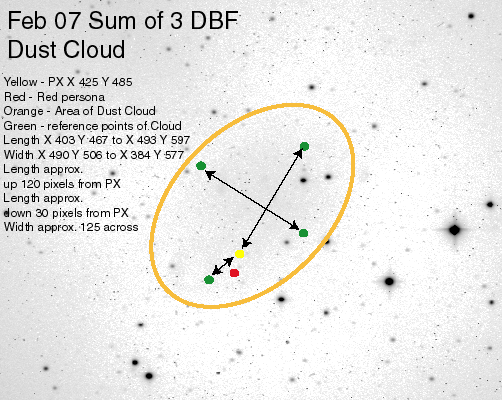Feb 7, 2003 Dust Cloud Size
- What I have circled is identifiable on the image. It shows as a brighter (inverted darker) area compared to immediate surrounding area.
Something smaller within that circle as an outlined brighter cloud is not on the film. Something larger would be parted by the darker area
(inverted brighter). What I would suggest is the Dust cloud itself has some reflective properties which we have picked up. If this was a
camera issue I would expect the light area to be centered over the image center. The center of image is to the right of this light area.
That leads me to conclude it is something on the film. In Naji's comments on email re distance on Jan 26 he said 67 pixels is max 2D
distance of moons at that time. This brighter area on the image could include tail dust reflecting. Naji confirmed my calculation for 2D
max for tail at that time of 187 pixels.
-
 My measure shows the noted cloud of dust stretching out
120 pixels up/right of Planet X and another 30 pixels
down/left.
My measure shows the noted cloud of dust stretching out
120 pixels up/right of Planet X and another 30 pixels
down/left. - Width of cloud approx 125 pixels.
Total image 1024 X 1024 = 1048576 pixels
Dust Cloud 150 X 125 = 18750 pixels
18750 X 1.788 %
1048576 100
- This would indicate Dust cloud is covering 1.788 % of Feb
07 image. Which would equate to 1.35 % size of the moon
if Image = 75% of Moon.
- J. William Dell
-
- You can consider the Moons to be within 5 million miles of
Planet X, as the maximum distance they will stray.
- ZetaTalk™ (dated Jan 25, 2003)
Maximum Moons tail size at - 3 SunPluto = 5e6 / 74617 = 67 Pixels
- Note: This is a 2 D distance, not a 3 D distance. We are
looking at a projection of 3 Dimensional objects into a 2 D
surface. If 2 objects are behind each other, and one is
slightly to the side, then you cannot really tell how far apart are they by looking at a 2 D image.
- Naji (dated Jan 26, 2003)
 My measure shows the noted cloud of dust stretching out
120 pixels up/right of Planet X and another 30 pixels
down/left.
My measure shows the noted cloud of dust stretching out
120 pixels up/right of Planet X and another 30 pixels
down/left.